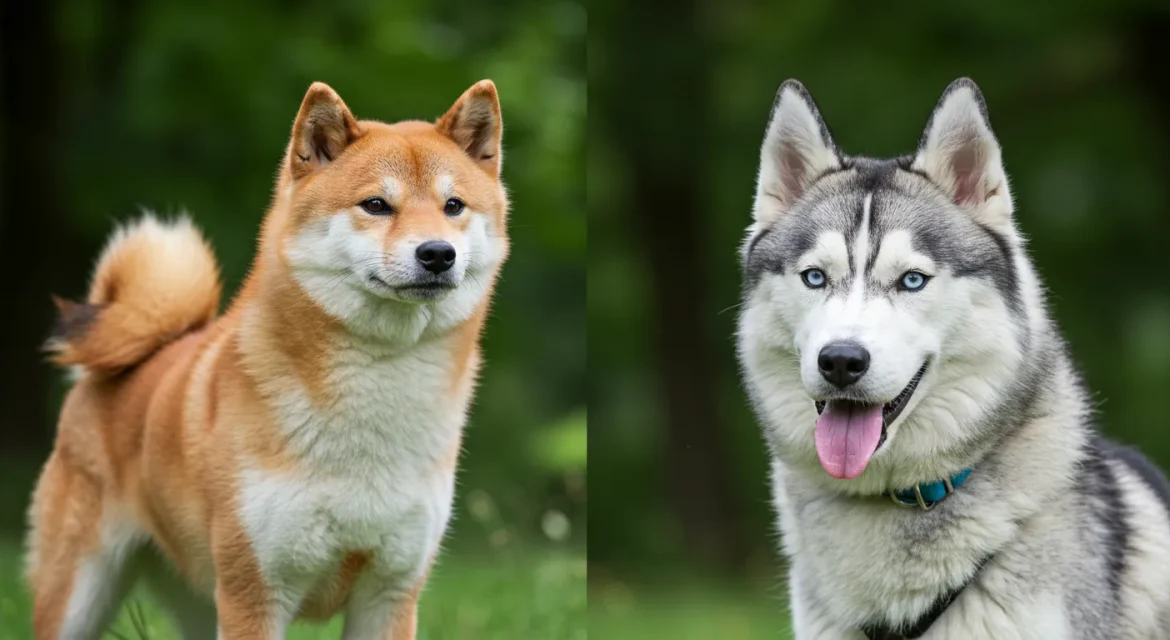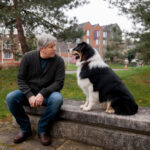Choosing the ideal dog starts with understanding the differences between breeds to ensure they match your lifestyle and expectations. Among the most popular dog breeds, the Shiba Inu and the Siberian Husky are two strikingly beautiful and intelligent dogs with completely different personalities and care requirements.
Whether you’re a first-time dog owner or an experienced pet parent, understanding the differences between a Shiba Inu and a Husky will help you choose a companion that matches your lifestyle, energy levels, and living situation.
In this blog, we’ll explore the origin, size, personality, training needs, grooming, and overall suitability of both breeds so you can confidently make the best choice for your future furry friend.
Overview: Shiba Inu vs Husky
| Shiba Inu | Husky |
| ⇲ A Japanese breed for hunting small game. Independent and fox-like. | ⇲ Bred in Siberia for pulling sleds. Social and pack-oriented. |
| ⇲ 13.5–16.5 inches tall, 17–23 pounds. Fox-like face and curled tail. | ⇲ 20–24 inches tall, 35–60 pounds. Wolf-like face with erect ears and bushy tail. |
| ⇲ Spirited, bold, and independent. Often acts like a cat. | ⇲ Friendly, outgoing, and energetic. Love’s people and other dogs. |
| ⇲ Needs patient and positive training. Can be stubborn. | ⇲ Intelligent but stubborn. Needs consistent, firm training. |
| ⇲ Energetic with daily walks and off-leash play. | ⇲ Needs vigorous daily exercise and mental stimulation. |
| ⇲ Heavy seasonal shedding. Weekly brushing helps. | ⇲ Sheds heavily year-round. Needs frequent brushing. |
| ⇲ Lives 12–15 years. May face allergies, knee, or hip issues. | ⇲ Lives 12–14 years. May have eye issues, hip dysplasia. |
| ⇲ Can adapt to apartment life if exercised well. Low odor. | ⇲ Needs space and activity. Not suited for small apartments. |
| ⇲ Best for experienced owners with limited space. | ⇲ Best for active owners with time, space, and commitment. |
1. Origin and Breed History
Shiba Inu
The Shiba Inu is a small but mighty breed originating from Japan. It is one of the oldest native breeds, dating back thousands of years. Shibas were initially bred for hunting small game like birds and rabbits in mountainous terrain. They are deeply ingrained in Japanese culture and are known for their fox-like features and independent personality.
Husky
The Husky originated in northeastern Siberia, where the Chukchi people bred them for their strength, stamina, and ability to pull sleds across long distances in harsh, frozen climates. With their roots as working dogs, Huskies are built for endurance and thrive in colder environments. Today, they are admired worldwide for their striking wolf-like features, expressive eyes, and energetic, friendly personalities.
2. Appearance and Size
Shiba Inu
The Shiba Inu is a small and compact breed, standing at 13.5 to 16.5 inches tall and weighing between 17 to 23 pounds. It features a thick double coat that comes in colors such as red, sesame, black and tan, or cream. Shibas are known for their curled tails, upright ears, and fox-like facial expressions, giving them a sharp and alert appearance.
Husky
The Husky is a larger, more athletic breed, measuring 20 to 23.5 inches in height and weighing between 35 to 60 pounds. They have a dense double coat, often seen in black, white, gray, red, or agouti. Huskies are instantly recognizable by their almond-shaped blue or bi-colored eyes, fluffy tails, and distinct wolf-like faces. Their size and features make them well-suited for colder climates and active lifestyles.
3. Personality and Temperament
Shiba Inu
Shiba’s are fiercely independent and can sometimes come across as aloof. They form strong bonds with their families but may be standoffish with strangers. They’re alert, confident, and can be possessive of their toys or food. Unlike most dogs, Shibas like to keep themselves clean, similar to cats.
Husky
Huskies are the social butterflies of the dog world. They’re friendly, energetic, and love being around people and other dogs. However, their high prey drive can make them unsafe around small animals. Huskies are vocal and expressive, often “talking” with their owners through howls and other sounds.
4. Intelligence and Trainability
Shiba Inu
Shiba’s are incredibly intelligent, but their independence makes them one of the most challenging breeds to train. They tend to ignore commands unless they see a reason to follow them. Training a Shiba requires consistency, patience, and positive reinforcement.
Husky
Huskies are also smart, but they love testing boundaries. They can learn quickly but may choose not to listen. Without firm training and enough stimulation, Huskies often become destructive or attempt to escape.
5. Energy Levels and Exercise Needs
Shiba Inu
Shiba’s have moderate energy levels. A few daily walks and some playtime indoors or in a fenced yard usually suffice. They are not overly demanding but do benefit from mental enrichment and short bursts of activity.
Husky
Huskies are high-energy working dogs. They require at least 1–2 hours of vigorous exercise every day. Without enough physical and mental activity, Huskies may become frustrated, anxious, and destructive.
6. Grooming and Shedding
Shiba Inu
Shiba’s are naturally clean and do not require frequent bathing. However, they do shed heavily, especially during seasonal coat changes. Brushing them 1–2 times a week (daily during shedding seasons) is ideal.
Husky
Huskies have a thicker double coat and experience intense seasonal shedding known as “blowing their coat.” They require frequent brushing to manage loose fur and avoid matting. Like Shibas, Huskies are clean dogs and have minimal odor.
7. Living Environment Suitability
Shiba Inu
Shiba’ adapt well to apartment living as long as they receive enough exercise. They are not overly noisy and tend to be respectful of quiet spaces. However, they must be kept on a leash or in a secure yard. Shiba’s have a strong prey drive and tend to run off when off-leash.
Husky
Huskies do best in homes with large, securely fenced yards. Apartment living is possible, but it’s challenging without ample exercise. They are notorious escape artists and diggers and are prone to howling if left alone too long.
8. Behavior Around Kids and Other Pets
Shiba Inu
Shiba’s are better with older children who understand boundaries. They don’t tolerate rough play and may growl or snap if pushed too far. With other pets, Shibas can be territorial and dominant, especially with dogs of the same gender.
Husky
Huskies are known to be great with children due to their gentle and playful nature. They enjoy the company of other dogs but may not get along with small animals like hamsters or cats unless raised with them from a young age.
9. Health and Lifespan
Shiba Inu
Shiba Inus are known for their sturdy build and generally good health. With an average lifespan of 12 to 15 years, they can be wonderful long-term companions. However, they may develop certain conditions such as hip dysplasia, patellar luxation, eye disorders, or allergies. Regular vet checkups and proper care help them stay healthy and active throughout their life.
Husky
Huskies typically live for around 12 to 14 years. They are a strong and resilient breed but can be prone to specific health issues like hip dysplasia, cataracts, progressive retinal atrophy (PRA), and thyroid disorders. Early health screenings and good care go a long way in keeping them energetic and thriving.
10. Cost and Maintenance
Shiba Inu
A Shiba Inu usually costs between $1,200 and $2,500, depending on its lineage and breeder reputation. Their smaller size means they consume less food, and their grooming needs are moderate, making their ongoing maintenance costs relatively lower compared to larger breeds.
Husky
Huskies are generally priced between $900 and $2,000. While their upfront cost may be slightly lower than a Shiba Inu’s, their monthly expenses are higher. Being larger, they eat more, require more grooming, and need plenty of exercise to stay healthy, which adds to their overall upkeep.
Also Read:
Conclusion
Choosing between a Shiba Inu and a Husky depends entirely on your lifestyle, experience, and environment. Shiba’s are small, independent, and clean dogs that thrive in quieter, controlled spaces like apartments. They are loyal but reserved, making them great for experienced owners who prefer low-maintenance companions.
Huskies, on the other hand, are larger, highly social, and energetic. They need lots of space, regular exercise, and strong leadership. Ideal for active families or individuals who enjoy outdoor adventures, Huskies offer affection, playfulness, and strong pack loyalty but they require a lot of time and attention.
Both breeds are intelligent, beautiful, and rewarding in their own ways. The key is to match the dog’s needs with your lifestyle. With the right care and commitment, either of these amazing breeds can become a loving and lifelong companion.
FAQs
1. Is a Shiba Inu a type of husky?
No, a Shiba Inu is not a type of Husky. They are two distinct breeds from different parts of the world. Shiba’s are small hunting dogs from Japan, while Huskies are larger sled dogs from Siberia.
2. Are Shibas or Huskies better for first-time dog owners?
Shibas can be stubborn and aloof, while Huskies require a lot of attention and exercise. Neither is ideal for complete beginners, but Huskies may be easier to socialize.
3. Who requires more grooming: Shiba Inu or Husky?
Both breeds shed heavily, but Huskies need more frequent brushing due to their thicker coat and intense seasonal shedding. Shiba’s are cleaner and lower-maintenance in comparison.
4. Which breed is more vocal?
Huskies are known for being extremely vocal; they howl, “talk,” and whine often. Shiba’s are quieter overall but can make a high-pitched “Shiba scream” when frustrated or excited.
5. Do Shiba Inus or Huskies get along better with other dogs?
Huskies are usually very social and get along well with other dogs. Shibas, on the other hand, can be territorial and dominant, especially toward dogs of the same sex. Early socialization is crucial for both breeds.




